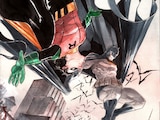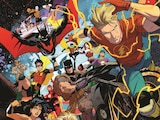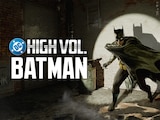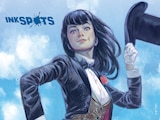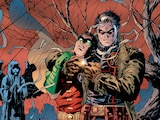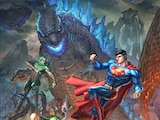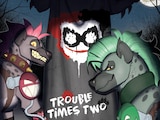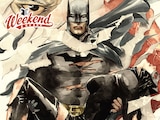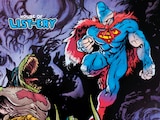Even with the weather heating up, the event of the summer is sending chills down our spines. In “Knight Terrors,” the mysterious villain known as Insomnia unleashes a plague of nightmares, making the heroes and villains of the DC Universe live through their greatest fears. In a dreamscape gone wild, the worst thing our characters can imagine is made real to them…but that means it’s first up to their writers to dream it up.
We got personal with some of the authors of “Knight Terrors” to talk about their own nightmares and how that’s equipped them to be truly horrible to our favorite characters. Jeremy Adams and Alex Segura together are bringing us Knight Terrors: Green Lantern, giving us complementary tales of what haunts Hal Jordan and his nemesis Thaal Sinestro. Tini Howard is getting inside the minds of Gotham’s leading ladies in Knight Terrors: Catwoman and Knight Terrors: Harley Quinn. Matthew Rosenberg is daring to expose the Clown Prince of Crime’s psyche laid bare in Knight Terrors: The Joker. Mark Waid is exploring the fears of Billy Batson’s super-powered sister Mary Bromfield in Knight Terrors: Shazam. And Dennis Culver reminds us that the waking world is no picnic either in Knight Terrors: Zatanna. Just remember, it’s only a dream…
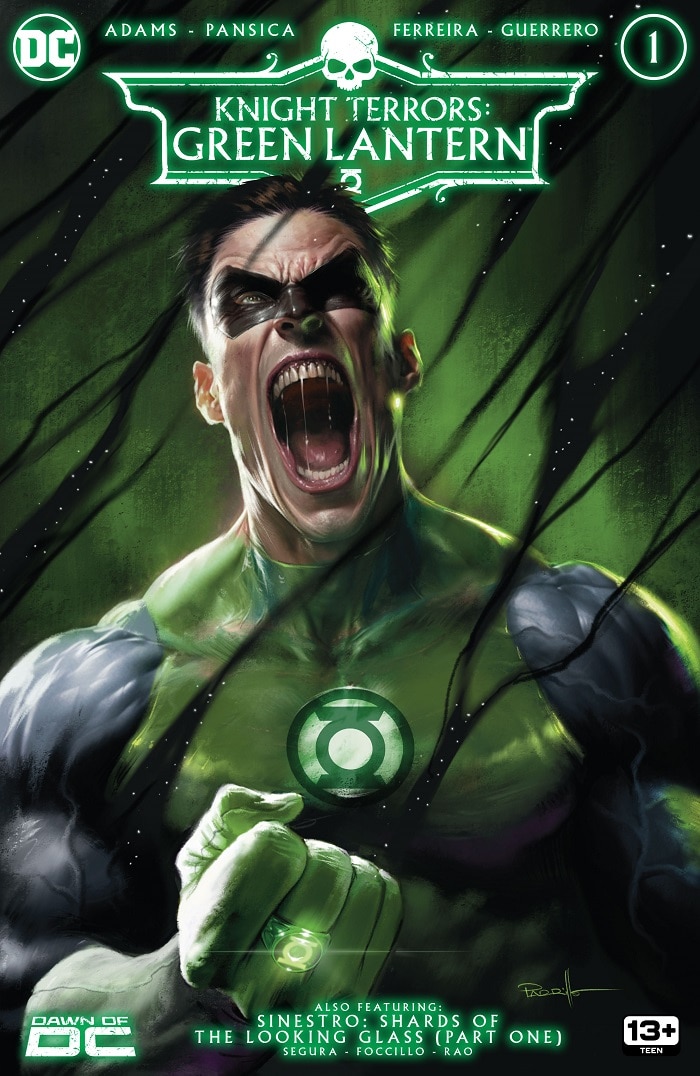
What are your characters having nightmares about in “Knight Terrors”?
Jeremy Adams: The problem with Hal is he’s a man that has spent a good chunk of his superhero career overcoming FEAR on all levels. I think that presents a unique problem for Insomnia and crew, which is the hook I use to retell and revisit some of Hal's biggest moments. Of course, they aren't exact to his memory. We can see how this Nightmare Wave is manipulating things, changing them, looking for a foothold into Hal's psyche.
Alex Segura: Sinestro is having nightmares about the thing that matters most to him—himself! He's being dragged unwillingly through his darkest moments and greatest failures, as his two halves duke it out to determine just who Sinestro is…and might become.
Tini Howard: For Catwoman, it’s guilt, pain and the past. She's in a powerful, but tenuous place right now, so we're taking her to a Gotham where the worst has happened. Harley… Oh, this one is a surprise.
Dennis Culver: In Knight Terrors: Zatanna, our hero is one of the people still awake on Earth after Insomnia unleashes his nightmare wave. That doesn't mean Zatanna's troubles are over! Alone and outnumbered, Zatanna uses her magic to summon any hero awake and available to help her, but is surprised when it's one of the World's Strangest Superheroes: Robotman from the Unstoppable Doom Patrol!
This is the first time these two have ever met and neither are happy about it! They have to figure out this waking nightmare before the Sleepless Queen and her Knights kill Zatanna's sleeping allies: Wonder Woman and Detective Chimp.

Mark Waid: There's a surface level and a deeper level. On the surface level, Mary Marvel's nightmare is about not being there for her family. She, of course, has wildly underestimated her reliability, but humble people do that.
Matthew Rosenberg: With a character like the Joker, delving into what really scares him feels really complicated on the surface. The man is a living, breathing nightmare for so many of the people in Gotham. But that's the secret. What scares the Joker the most is being boring. His need to be the center of attention, to cause chaos, to have a rivalry with Gotham's greatest heroes, all of those things help define him. So, we took all that away from him and got him a day job.
Tell us about a nightmare YOU’VE had. What did it reveal, and how did it inspire you?
Jeremy Adams: I have nightmares all the time! Usually, after I eat a pizza (and I mean a WHOLE pizza, so...no wonder!) Most of my nightmares revolve around things happening to my family, though I had a peculiar one the other night where I couldn't find the right booth at a comic convention for a signing. That is new!
As far as being inspired by them...not really. I have had a few that were germinal ideas for stories. I always appreciate something constructive coming out of something terrifying.
Mark Waid: Like clockwork, I dream about comic conventions at least once a week, but never in a good way. Never in a fun, "cool, comics I've never seen before!" way. Always in a “I'm lost, where am I supposed to be? I can't find my hotel!” way. It doesn't take Freud to understand that this represents my subconscious anxiety about all conventions, which I enjoy but where this introvert is required to play extrovert all day.

Alex Segura: My recurring nightmare is fairly common. I'm back in high school, except I'm my current age, and I've somehow forgotten a class credit and everyone around me is younger, except my old teachers—who are still there! If I'm really stressed, I'm not wearing shoes in the dreams, either. Not sure what it reveals—a fear of forgetting something? It certainly inspires me to keep in touch with old friends!
Tini Howard: I have a weird recurring nightmare where I'm stuck inside an indoor city or mall, a sprawling network of commerce and travel—like an airport or cruise ship. I have so many dreams there. I don't know if it's revealed anything yet, but the feeling of ending up somewhere vaguely familiar, but under unfamiliar circumstances, is absolutely something that’s inspired me.
Dennis Culver: The dreams I usually remember are the anxiety dreams you have right before you wake up. A regular one I have is I'm still at an old job where I had a physical inbox I had to check by 9 am every morning, but I realize that I haven't been here in years and haven't checked the box during all that time. Terrifying!
Matthew Rosenberg: I used to have this recurring nightmare that I would accidentally drive a car off a bridge and all the people I loved were inside it. It was a really long drop, so I just had all this time to tell everyone I was really sorry I got us all killed. I'm not sure what it revealed to me other than I feel like I really let people down a lot. But the joke is on you, subconscious! I already knew that.
I'm not sure it inspired me to do anything other than not go over bridges, which is tricky because I live on an island.

Comics are a static medium where the reader controls the pace. Without the element of surprise and lack of control that comes from film, how do you use comics to pace and tell a horror story?
Tini Howard: This is a great question. I think these stories are personal horror, meaning that they're scariest to the characters experiencing them. Thinking of how each character's subconscious would respond to this, what symbols from their past would come up to represent these concepts? Leila Leiz makes us a beautiful story in a dark place—for Catwoman, the horror is losing that light in the darkness. In the Harley issue, Hayden Sherman pulls out all the stops—those pages move. Can't wait for you to see it.
Mark Waid: Great question. And, in fact, knowing that your “jump scares” are dependent on page turns, of which there are a limited amount, I chose to focus less on shock in this nightmare and more on the unsettling, Kafka-esque trappings of dream logic—those nightmares that are less about terror than unease, where we move through them not reacting, so much as feeling creeped out.
Jeremy Adams: I kind of feel like sequential art lends itself to horror. It's like taking polaroids of something terrible. As much as we control the pace as a reader, horror has this tendency to pull you in. Comics kind of build the tension...what's going to happen when I turn the page?!
Plus, getting to see the artwork is just so great. It's amazing to see grotesque monsters, and really be able to take as much time as you want to examine them. Eduardo Pansica, in the GL book, really had me staring at his work for a while.

Alex Segura: I think the key to creating suspense on the comics page is pacing and understanding the elements of the medium: dialogue, panel structure and layout, and the page turn. All tools you can use to create surprise and increase the “speed” of the story, all things that can make a “regular” story seem more intense and terrifying.
I was blessed to work with a great artist in Mario "Fox" Foccillo, who was adept at taking my general ideas and weaving them into the surrealist, trippy story we ended up with. For our Sinestro tale, it was very internal—I wanted to explore how someone like Sinestro grapples with not only failure, but fear. What scares a master of fear? That was fun to explore.
Dennis Culver: Thankfully, comics can pull tricks from many mediums and people have been writing and telling tales of terror long before film! Caption boxes give us the ability to get inside the heads of our characters in a way film never could, revealing layers of fear that a facial expression might only hint at. Also, comics aren't as static as you think! Comics are interactive in a way films will never be. The reader helps with every page they turn in a comic, and who knows what might be lurking on the other side?
Matthew Rosenberg: Luckily for me, the horrors in our story are about monotony and boredom. And those are actually pretty easy to replicate in comics! (That's a joke, people. Calm down.)

What would you say is your single biggest fear?
Alex Segura: Oh, I hate heights. And I have a fear of drowning, despite being a decent swimmer. The thing about fear is that it doesn't have to be rational—we're irrational creatures!
Mark Waid: Existentially? Captivity in any form, which is probably why I took to the Flash so readily since his power is all about freedom. In hard reality? Insects, especially the skittery ones. Ghuuuuuh.
Dennis Culver: To quote Major Garland Briggs, “The possibility that love is not enough.”
Matthew Rosenberg: This feels like the kind of interview a super-villain would give. I guess my biggest fear is losing the people I care about? Or seeing them suffer and being unable to help. That's a big fear for me. Also cats. They freak me out.
Tini Howard: I am a Scorpio, so I will not be answering that question publicly!
Jeremy Adams: And have you use it against me? Hah! No...my biggest fear, like all writers, is that you'll figure out that I have no idea what I'm doing.
The first issues of Knight Terrors: Green Lantern, Knight Terrors: Shazam, Knight Terrors: Zatanna, Knight Terrors: The Joker, Knight Terrors: Catwoman and Knight Terrors: Harley Quinn, along with the first issues of all of the other Knight Terrors miniseries, are now available in print and as digital comic books.





